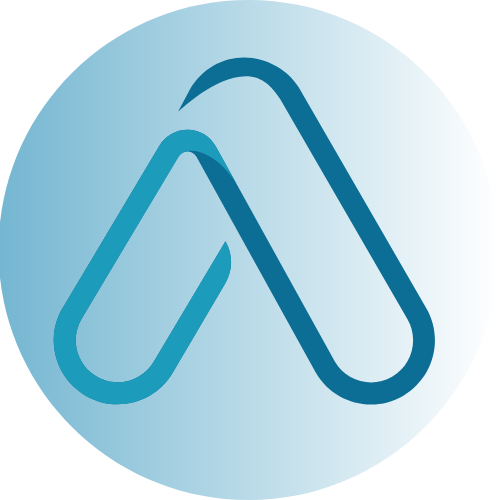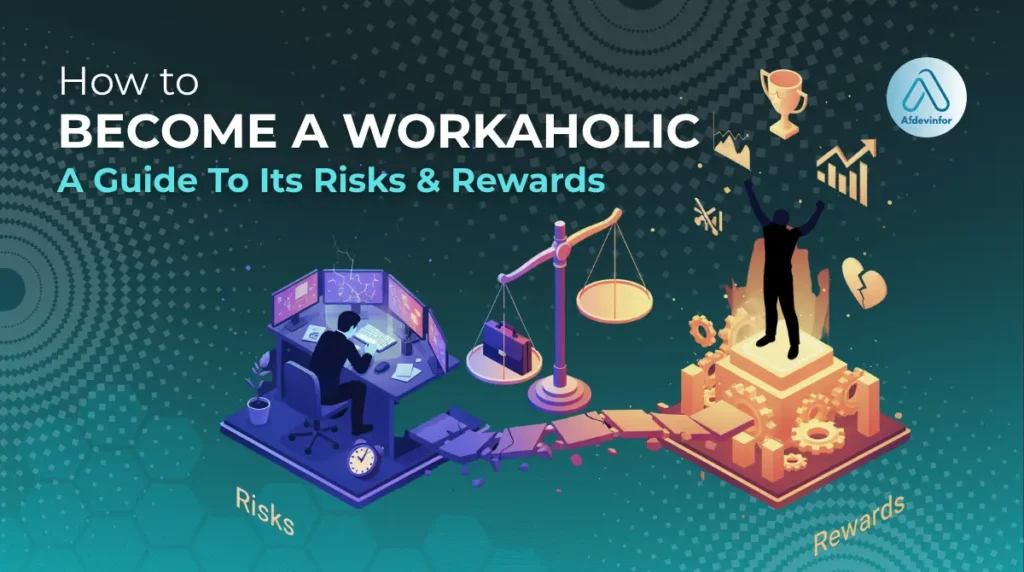In a world that rewards high output, I understand why you’re searching for how to become a workaholic; the allure of extreme productivity is stronger than ever. For over a decade, I’ve navigated the landscapes of high-performance tech and cybersecurity, and I’ve seen firsthand what it takes to push the limits of productivity. But I’ve also seen the cliff edge.
This guide is different because it’s built on a dual focus: I’ll give you the practical frameworks to maximize your output, but I’ll also equip you to manage the very real risks. This isn’t about glorifying ‘hustle culture’; it’s a responsible roadmap to intense ambition.
Here’s what you’ll find inside:
- The ‘Why’: A self-diagnostic to understand your true motivations.
- The ‘How’: The mindset shifts and actionable habits for peak performance.
- The ‘Risks’: An honest look at the costs to your health and relationships.
- The ‘Alternatives’: Smarter strategies for high performance without self-destruction.
1. Should you even become a workaholic?
Before we dive into the ‘how,’ we need to address the ‘why.’ This is the most critical first step, a phase of self-reflection that many guides overlook. Understanding what drives your desire to work relentlessly is the key to ensuring your ambition serves you, rather than consumes you. Are you driven by passion, fear, or a need to escape?
1.1. A self-diagnostic checklist
To help you understand your motivations, I’ve put together this honest checklist. Take a moment to answer these questions, not with the answer you think you should give, but with the one that feels most true.
- Is your sense of self-worth heavily tied to your professional achievements? (Yes/No)
- Do you find yourself thinking about work constantly, even during leisure time or with family? (Yes/No)
- When you start a new project, do you tend to neglect your relationships or hobbies? (Yes/No)
- Are you using work to avoid dealing with other problems or feelings in your life? (Yes/No)
- On a scale of 1-5, how anxious or guilty do you feel when you are not working or being productive? (1 = Not at all, 5 = Extremely)
- Do you find it difficult to ‘switch off’ your brain after the workday ends? (Yes/No)
Interpreting Your Results: If you answered ‘Yes’ to three or more questions or rated yourself a 4 or 5 on the anxiety scale, it’s a strong indicator that you may be at risk for unhealthy work habits. It doesn’t mean you shouldn’t pursue your goals, but it does mean you must pay extremely close attention to the safeguards and sustainable strategies I discuss in Section 5.
2. How to rewire your brain for extreme focus
Becoming a workaholic by choice is possible, but it requires a conscious and significant mental rewiring. It’s about more than just working longer hours; it’s a fundamental workaholic mindset shift where work becomes your central identity and progress becomes an obsession. This section is your mental toolkit for making that change.
“The successful warrior is the average man, with laser-like focus.”
Bruce Lee
2.1. The art of prioritizing work above all else
Achieving extreme output means making work the undisputed priority. This involves adopting a ruthless prioritization framework, like the Eisenhower Matrix, where you actively categorize and eliminate tasks that aren’t both urgent and important to your primary goals.
It requires the mental discipline to consciously de-prioritize social events, hobbies, and other forms of leisure that don’t directly contribute to your work objectives. This isn’t about balance; it’s about a deliberate and focused imbalance in favor of your professional ambitions.
| A Stark Warning: This step is about making conscious trade-offs. Be honest with yourself about what you are willing to sacrifice in the pursuit of your goals. Extraordinary results often demand extraordinary sacrifices, and you must decide if the price is one you’re willing to pay. |
2.2. A strategy to beat procrastination at work
To maintain a high-output lifestyle, you have to eliminate the friction that leads to procrastination. My go-to strategy is to turn work into a series of small, manageable challenges. If you’re struggling with how to motivate yourself to work more, it’s often because the tasks seem too daunting. The key is to break them down and build momentum.
Here are a few of my favorite psychological tricks, which I call ‘Procrastination Busters’:
- The 5-Minute Rule: Commit to working on a task for just five minutes. More often than not, starting is the hardest part, and after five minutes, you’ll find the flow to continue.
- Eat the Frog: Identify your most difficult or dreaded task for the day and tackle it first. Once it’s done, the rest of your day feels easier, and you build powerful momentum.
- Reframe the Task: Instead of seeing a task as a chore (‘I have to write this report’), reframe it as a challenge or a game (‘Can I outline this report in under 25 minutes?’). This shifts your mindset from obligation to engagement.
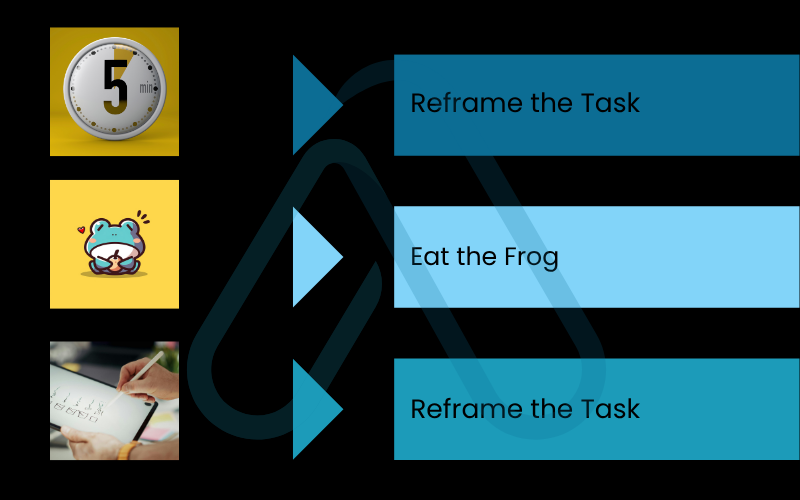
3. Actionable habits and routines for maximum output
A mindset shift is nothing without a system to support it. This section provides the step-by-step framework for building a high-performance work lifestyle. These are the practical, increase-productivity habits and routines I’ve refined over years of hands-on experience.
3.1. The time-blocking and deep work method
The most productive people don’t leave their days to chance; they architect them. Time-blocking is a method where you schedule every part of your day, assigning a specific task or purpose to every block of time. This eliminates decision fatigue and creates a clear plan of attack. I combine this with the principles of ‘Deep Work,’ a concept from Cal Newport that emphasizes distraction-free, highly focused concentration. This means turning off notifications, closing unnecessary tabs, and dedicating large, uninterrupted chunks of time to your most cognitively demanding tasks.
Here is a sample time-blocked schedule for a day of deep work:
| Time Slot | Task | Notes |
|---|---|---|
| 8:00 AM – 8:30 AM | Daily Planning & Prioritization | Review goals, ‘eat the frog’ task identified. |
| 8:30 AM – 11:30 AM | Deep Work Block 1 | Phone on silent, notifications off. Focus on top priority. |
| 11:30 AM – 12:00 PM | Admin & Email | Handle quick, low-focus tasks. |
| 12:00 PM – 1:00 PM | Lunch & Walk | Scheduled break. Disconnect completely. |
| 1:00 PM – 4:00 PM | Deep Work Block 2 | Tackle secondary major project. |
| 4:00 PM – 5:00 PM | Meetings / Collaborative Work | Group focused tasks together. |
3.2. Optimizing your environment for non-stop productivity
Your workspace, both physical and digital, should be an engine for focus, not a source of distraction. The goal is to minimize friction so that starting and continuing work is the easiest possible option.
Here are some quick tips to optimize your environment:
- Physical Environment: Invest in an ergonomic chair and desk setup to minimize physical discomfort. Keep your desk clear of everything except the essentials for your current task. Use noise-canceling headphones to block out auditory distractions.
- Digital Environment: Use distraction-blocking software (like Freedom or Cold Turkey) to restrict access to social media and news sites during work blocks. Organize your digital files into a logical folder structure so you’re never wasting time searching for documents. Use a single monitor to promote focused work on one task at a time.
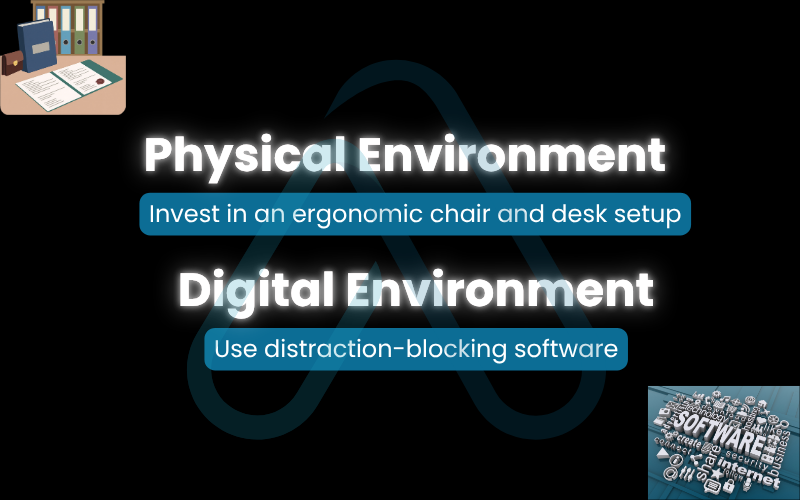
3.3. Tools to enforce work discipline
In my experience, the right technology can act as a powerful system to enforce the habits you want to build. These tools aren’t just for organization; they are for discipline. They help automate your decisions so you can save your mental energy for the work itself.
Here are some tools I recommend, categorized by function:
- Project & Task Management: Tools like Todoist or Asana allow you to break down huge goals into tiny, actionable steps, creating a clear and motivating roadmap.
- Focus Timers: The Pomodoro Technique is fantastic, and apps like Focus@Will or Forest provide timers and ambient sounds to help you stay locked in for set intervals.
- Note-Taking & Knowledge Management: A centralized ‘second brain’ like Obsidian or Notion ensures that ideas and information are captured and organized, freeing your mind to focus on execution.
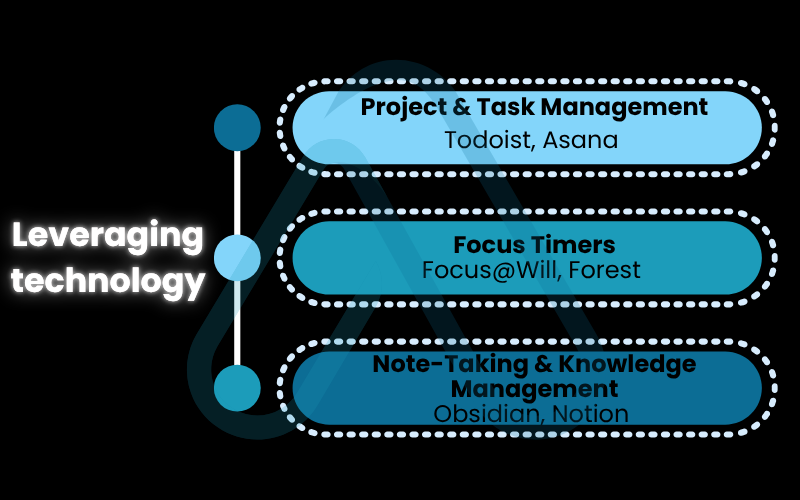
4. The other side of the coin between dangers, consequences, and symptoms of work addiction
| Warning: The pursuit of extreme productivity has significant risks. This section is essential reading. Unlike many articles that glamorize overwork, my responsibility as an expert is to give you the full picture. Ignoring these dangers is a direct path to burnout. |
While ambition is admirable, a compulsive need to work, known as work addiction, has severe consequences. According to the American Psychological Association, overwork is linked to a host of negative outcomes. Understanding the work addiction symptoms and hustle culture dangers is crucial for anyone considering this path.
4.1. Short-term gains vs. long-term burnout
The allure of workaholism lies in its immediate rewards. However, these are often traded for devastating long-term costs. Burnout isn’t just feeling tired; it’s a state of chronic physical and emotional exhaustion, often accompanied by cynicism and a sense of ineffectiveness. It’s the result of your body’s prolonged response to chronic stress, depleting your mental and physical resources over time.
Here is a direct comparison of the trade-offs involved:
| Short-Term Gains | Long-Term Consequences |
|---|---|
| Increased income, promotions | Chronic stress, leading to health problems |
| Praise and professional recognition | Severe burnout and decreased productivity |
| A feeling of being indispensable | Damaged or destroyed personal relationships |
| Avoidance of other life problems | Anxiety, depression, and other mental health issues |
4.2. The impact on your health and relationships
The price of unchecked workaholism is paid with your well-being. It’s not a question of ‘if,’ but ‘when’ the consequences will appear. From my perspective, no professional achievement is worth sacrificing your health or your most important relationships.
Here’s a breakdown of the specific areas impacted:
- Physical Health: Research consistently links overwork to a higher risk of cardiovascular disease, high blood pressure, a weakened immune system, and chronic fatigue. Sleep deprivation becomes the norm, further compounding these issues.
- Mental Health: Work addiction is strongly correlated with anxiety disorders, depression, and increased substance use as a coping mechanism. The inability to ‘switch off’ leads to a constant state of mental arousal and stress.
- Social Life: When work becomes the sole focus, relationships with family and friends wither. You may be physically present but mentally absent, leading to alienation, resentment, and profound loneliness.
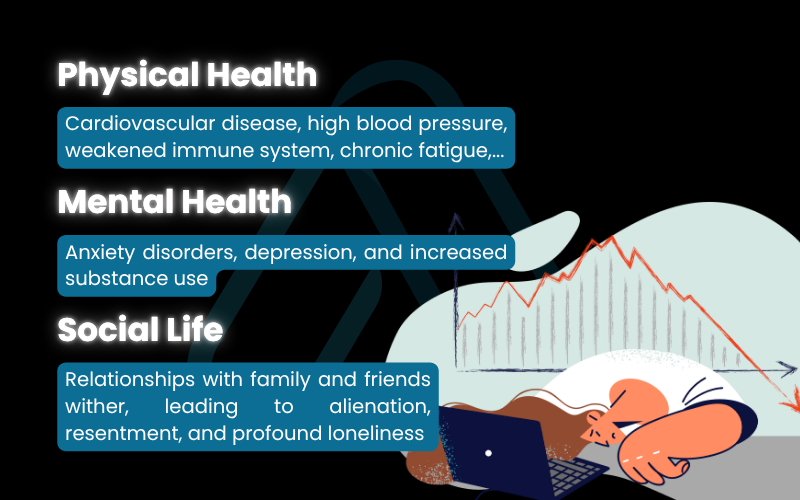
5. High performance without self-destruction
After seeing the risks, you might be wondering if there’s a better way. There is. You can achieve incredible results without sacrificing your health and happiness. This section is about building sustainable work routines and providing a smarter, more effective alternative to brute-force workaholism.
5.1. Setting boundaries and recognizing warning signs
If you choose to operate at a high intensity, you must be hyper-vigilant about self-preservation. This means setting firm boundaries and learning to recognize the early warning signs of burnout before it takes hold.
Here are the early warning signs you must watch for:
- Increasing cynicism or negativity about your work.
- A noticeable drop in your energy levels and persistent fatigue.
- Feeling less effective or accomplished, even when working long hours.
- Irritability and impatience with colleagues and loved ones.
- Difficulty concentrating and making simple decisions.
To counteract this, establish non-negotiable self-care protocols. This includes hard stops for your workday (e.g., no work after 7 PM), scheduled digital detoxes, and prioritizing sleep, exercise, and nutrition as if they were critical business appointments.
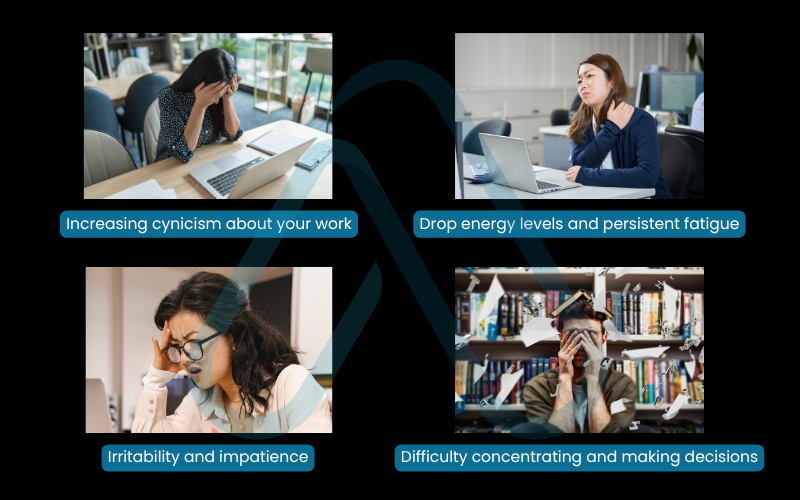
5.2. The ‘smart productivity’ model
The ultimate goal isn’t to work more; it’s to achieve more. The ‘smart productivity’ model prioritizes efficiency over sheer hours. It’s about maximizing your output during focused periods so you can have a rich, fulfilling life outside of work.
“Work expands so as to fill the time available for its completion.”
Parkinson’s Law
This model uses principles like Parkinson’s Law (give yourself less time to do a task, and you’ll do it more efficiently) and the 80/20 Principle (focus on the 20% of activities that yield 80% of the results). Instead of seeking work-life balance, it aims for work-life integration, where intense, focused work is complemented by strategic, high-quality rest. Peak performance, I’ve found, is almost always a result of strategic rest, not just relentless effort.
6. What psychologists and coaches say
To provide a balanced view, I’ve incorporated insights from different fields. This isn’t just my experience; it’s backed by professionals who study the mind and performance for a living. Here’s a mini-roundtable on this complex topic.
Afdevinfo: Is there a difference between a hard worker and a workaholic?
Dr. Anya Sharma (Clinical Psychologist): Absolutely. The key difference lies in compulsion and internal pressure. A hard worker is driven and engaged but can detach from work and enjoy other aspects of life. A workaholic feels an internal compulsion to work, often feeling guilt or anxiety when they are not productive. Their work is a means to escape other feelings, and they can’t ‘switch it off.’
Afdevinfo: Can intense work habits ever be healthy?
David Chen (Performance Coach): Yes, but only with extreme self-awareness and strict boundaries. I call it ‘strategic sprinting.’ An athlete doesn’t sprint a whole marathon. Similarly, you can have periods of intense work for a specific goal, but they must be followed by deliberate periods of recovery and rest. The danger arises when the sprint becomes a permanent state of being.
7. FAQs about how to become a workaholic
Here are some quick answers to the most common questions people ask about this topic.
What are the dangers of being a workaholic?
The primary dangers impact your well-being across the board. The main risks include:
- Physical Health Issues: Increased risk of heart disease, chronic stress, and fatigue.
- Mental Health Decline: Higher rates of anxiety, depression, and burnout.
- Relationship Damage: Alienation from family and friends due to neglect and mental absence.
Can you become a workaholic by choice?
Yes, you can choose to adopt the behaviors and mindset of a workaholic. As I detailed in Sections 2 and 3, it involves a conscious decision to change your priorities, habits, and psychological approach to work. However, it’s crucial to be aware of your underlying motivations to ensure you’re driven by healthy ambition, not compulsion or escapism.
How do I motivate myself to work more?
Motivation often follows action, not the other way around. I suggest starting with small, momentum-building habits from Section 2.2, such as the 5-Minute Rule to overcome initial resistance. Additionally, having clear, compelling goals and a structured daily plan, as outlined in Section 3, provides the clarity and direction needed to fuel motivation.
Is being a workaholic bad for your health?
Unequivocally, yes. When work becomes a compulsion rather than a choice, it is detrimental to your health. The chronic stress, sleep deprivation, and neglect of self-care associated with workaholism lead to a wide range of negative physical and mental health outcomes. I cover these in detail in Section 4.2.
Glossary of key terms
| Abbreviation | Full Term | Meaning |
|---|---|---|
| N/A | Eisenhower Matrix | A task management framework that prioritizes tasks based on urgency and importance, helping to decide what to do, delegate, or delete. |
| N/A | Deep Work | A term coined by Cal Newport for the ability to focus without distraction on a cognitively demanding task. |
| N/A | Parkinson’s Law | An adage stating that work expands to fill the time allotted for its completion, suggesting that shorter deadlines can increase efficiency. |
| 80/20 | 80/20 Principle (Pareto Principle) | The concept that, for many events, roughly 80% of the effects come from 20% of the causes. In productivity, it means focusing on the vital few tasks that deliver the most results. |
8. Final thoughts
My goal with this guide was to give you an honest, comprehensive answer to the question of how to become a workaholic. Extreme ambition is a powerful force, but it demands extreme self-awareness. You have the tools to re-engineer your mindset and habits for incredible output, but you also have the knowledge of the significant costs involved. The choice of which path to take, and how to walk it, is now yours.
Here are the most critical takeaways from our discussion:
- Know Your ‘Why’: Before changing your habits, use the self-diagnostic to understand if your drive comes from a place of healthy ambition or unhealthy compulsion.
- Mindset Precedes Action: True high performance starts with a conscious mental shift to prioritize and focus, eliminating procrastination at its source.
- Risks Are Real, Not Optional: The dangers of burnout, health problems, and damaged relationships are not possibilities; they are probabilities for those who ignore them.
- Work Smarter, Not Just Harder: Sustainable success comes from efficiency, strategic rest, and firm boundaries, not just from accumulating the most hours worked.
The ultimate achievement isn’t just working more; it’s designing a life where your work serves you, not the other way around. For more in-depth guides to help you thrive in your career, explore our Productivity & Automation categories on Afdevinfo.
